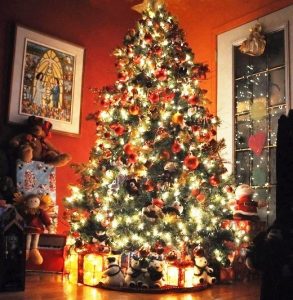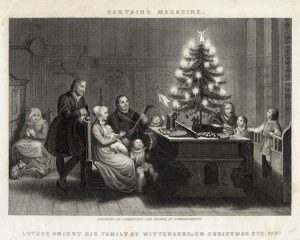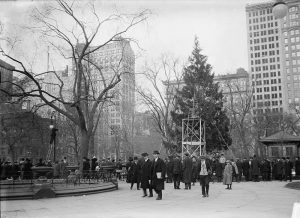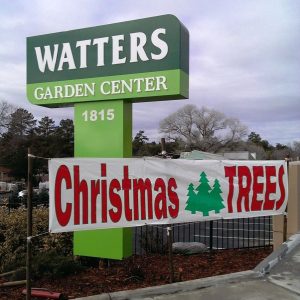By Ken Lain, the mountain gardener
My girls arrived home from college this week and the next day our family took the annual  trek to the garden center in search of this years Christmas tree. This is a special time at the Lain house that brings the memories flooding and the family together. The night usually consists of eggnog, ornaments, good stories and fondness of the season.
trek to the garden center in search of this years Christmas tree. This is a special time at the Lain house that brings the memories flooding and the family together. The night usually consists of eggnog, ornaments, good stories and fondness of the season.
More than 94 million trees will be used by Americans that will so something similar. A survey conducted by the American Christmas Tree Association, of those Christmas trees, displayed, 81 percent will be artificial and 19 percent will be real.
This is not a uniquely Arizonan celebration. The Christmas tree is the symbol of Christmas much like the Jack-O-Lanterns is for Halloween. Most Americans put their Christmas tree up possibly without knowing where the tradition comes from, or what its original meaning was. From a rich history and a chest full of fables, we look back thousands of years to unearth the story of the Christmas tree. This past is filled with both love and disdain.
Bringing evergreen plants indoors has a long tradition during the winter season. Thousands of years ago evergreen branches were hung over doorways and windows during winter to remind people that the liveliness of spring would soon be here.
The ancient Egyptians worshiped Ra, a god who had the head of a hawk and wore the sun as a blazing disk in his crown. During the winter solstice, the shortest day of the year, it was said that Ra began to recover from an illness. Egyptians would then fill their homes with green palm fronds in celebration of Ra’s triumph of life over death and the lengthening of days and spring to come.
Early Romans also marked the Winter Solstice with a feast called Saturnalia in honor of Saturn, the God of Agriculture. The feast meant that soon farms and orchards would begin plantings, green and grow fruitful. Along with the festivities, they decorated their homes and temples with evergreen boughs and small bits of metal.
But the traditional decorated Christmas tree as we all know it originated in Germany in the 16th Century. Devout Christians built pyramid-like structures and decorated them with evergreen branches and candles. It is said that the pyramid-like shape and triangular form of this tree, symbolized the Holy Trinity of God the Father, Son and Holy Spirit.
A story is told of Martin Luther, the 16th Century Protestant Reformer, as the first to add lighted candles to the tree. One night while walking home, developing a sermon in his head, he was mesmerized by the bright stars above twinkling through the evergreen trees. Inspired to recapture this scene for his family, he brought a tree inside his home and decorated its branches with candles.
American’s found the Christmas tree strange at first. The first record of one being on display in the 1830’s was by German settlers in Pennsylvania and was not accepted by most Americans. The tree was simply seen as a symbol of Paganism. Christmas was sacred to the New England Puritans and leaders tried hard to stamp out any “mockery” of this sacred event. Laws were even passed that penalized anyone who did anything on December 25 that was not a church related activity or gesture. In some townspeople were fined for hanging decorations.
In 1846 fashion forward Americans from the East coast societies followed an English tradition. An image of England’s popular Queen Victoria and her German Prince Albert was sketched in the Illustrated London News standing around a Christmas tree with the royal family. What was popular in the Royal court soon became popular in the mainstream. Thus, the decorated tree entered the landscape of an American Christmas.
By the 1890s ornaments arrived in America direct from Germany and Christmas trees were being commercially grown and sold. It was a status symbol at this time to have glass ornaments on the tree. In the shanty towns of the American West, it was not easy to find imported decorations. People made their own by piercing tin to create lanterns that held candles. By the turn of the century the Christmas tree had caught on everywhere, and Americans were decorating their trees with homemade ornaments and popcorn garland interlaced with berries and nuts.
New York City was the first city to erect its own tree in 1912. With the invention of  electricity, Thomas Edison and Edward Johnson were the first to create a strand of Christmas lights. This meant that the trees could glow for days and weeks, and town squares began erecting their own community trees. These community trees stand tall and have since become symbols of unification, and lift morale during times of war and difficulties.
electricity, Thomas Edison and Edward Johnson were the first to create a strand of Christmas lights. This meant that the trees could glow for days and weeks, and town squares began erecting their own community trees. These community trees stand tall and have since become symbols of unification, and lift morale during times of war and difficulties.
As far as the Lain house, we are part of the 19% that decorate a real tree for Christmas. Then again, we own a garden center and to put up a hunk of metal covered with dust covered needles is unfathomable. The true joy comes watching the kids unwrap each ornament out of the boxes stored in the basement, reliving the magic and excitement of each decoration year after year. These ornaments are like a family album hung on the tree with decorations from our travels, ornaments from our childhood and handmade baubles from family and friends. With the Christmas tree up and decorated, it is the welcome sign that this beautiful, joyous season is here.
from family and friends. With the Christmas tree up and decorated, it is the welcome sign that this beautiful, joyous season is here.
Yes, we still have both cut and living trees available at the garden center. They are fresh, pampered and filled with the fragrance of the season.
Merry Christmas everyone.
Until next week, I’ll see you at the garden center.
Ken Lain can be found throughout the week at Watters Garden Center, 1815 W. Iron Springs Rd in Prescott, or contacted through his web site at WattersGardenCenter.com or FB.com/WattersGardenCenter .

